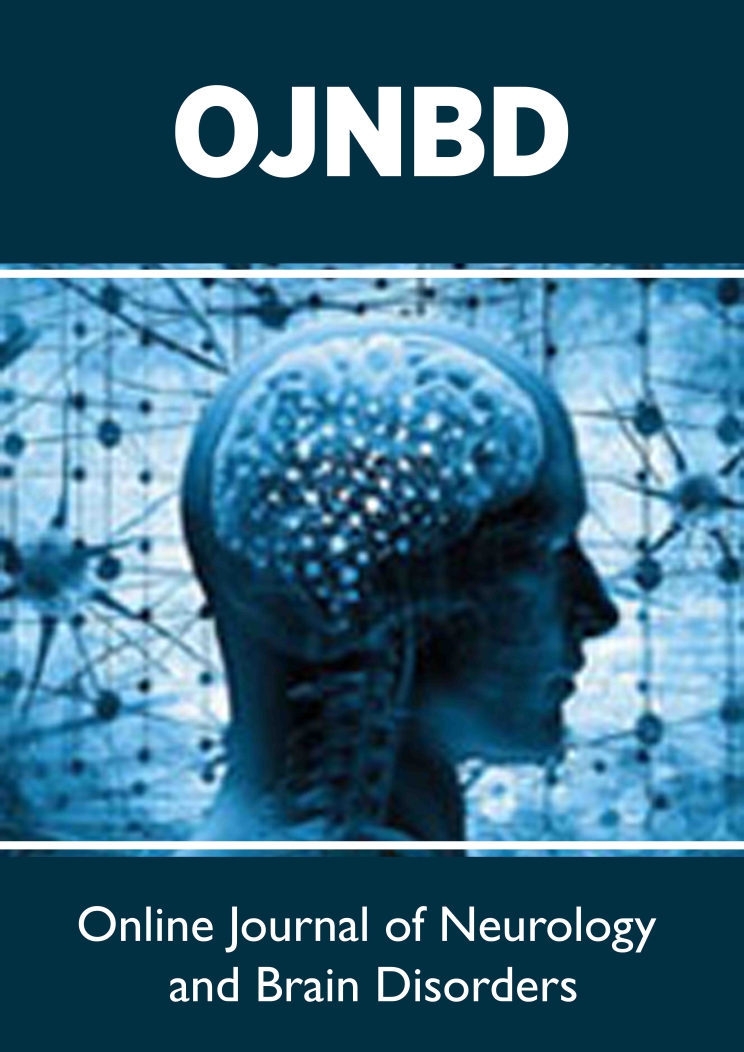
Lupine Publishers Group
Lupine Publishers
Menu
ISSN: 2637-6628
Case Report(ISSN: 2637-6628) 
Recurrent Calcified Hydatid Brain Cyst: Case Report Volume 6 - Issue 3
A Rahmouni*, B Abdenbaoui, G Ndekha, F Lakhdar, M Benzagmout, K Chakour and MF Chaoui
- Chu Hassan II Fez, Morocco
Received: June 06, 2022; Published: June 20, 2022
Corresponding author: SA Rahmouni, Chu Hassan II Fez, Morocco
DOI: 10.32474/OJNBD.2022.06.000236
Abstract
The cerebral localization of the hydatid cyst is rarely observed in the brain (0.5–4.5%). The calcified hydatid brain cyst is exceptional and occurs in less than 1%. We report an observation in our department of 25 years old woman with a history of surgery for hydatid brain cyst at the age of 8 years hospitalized for progressive left hemiparesis. Brain CT scan and MRI showed a temporo-parietal calcified mass with right temporal horn extension. The mass was removed in semi-elective procedure revealed a well capsulated calcified hydatid cyst. The clinical evolution was marked by massive intraventricular hemorrhage evident on postoperative scan. The calcified cerebral hydatid cyst remains a rare entity. Its symptomatology is non-specific hence, its diagnosis requires help of past medical history and neuro-imaging. It for sure poses therapeutic difficulties.
Keywords: Hydatid Cyst; Brain; Calcifications
Introduction
Hydatidosis or echinococcosis is an endemic parasitosis, known since ancient times [1]. It is observed all over the world and especially in sheep-rearing countries. It can affect all organs, especially the liver (60% of cases) and the lung (30% of cases) . Brain localization remains rare (1 to 4% of cases) . Calcified cerebral hydatid cyst is exceptional [2]. We report in this work a case collected in our department, and we discuss through this observation and the review of the literature the physiopathology of calcifications and the diagnostic and therapeutic difficulties they can generate.
Case Report
A 25-year-old women with a history of surgery for hydatid cyst at the age of 8 years was hospitalized in the neurosurgery department for the management of seizures and progressive onset of left hemiparesis. The examination showed a conscious patient, in good general condition apyretic, with left hemiparesis, without signs of intracranial hypertension or other associated signs. CT scan and Cerebral MRI performed with contrast showed a calcified mass in relation to the right ventricular junction measuring 6.1 cm x 4.3 cm and not showing enhancement after injection of gadolinium (Figures 1 & 2). The biological assessment and the fundal exams were normal, as well as the x-ray of the thorax and the abdominal ultrasound. The hydatid serology was negative. The surgical treatment consisted of a right parietal craniotomy. At the opening of the dura mater, calcified hydatid cyst and cerebral gliosis were discovered. Block ablation of the cyst was performed (Figure 3). The postoperative course was unfavorable, marked by massive intraventricular hemorrhage evident on post-operative scan. the patient has benefited external ventricular drain on 2nd post op day and the patient died on 6th post-operative day.
Figure 2: A: T1-weighted sagittal MRI showed a calcified mass in relation to the right ventricular junction. B: T2-weighted axial MRI not showing enhancement after injection of gadolinium.

Discussion
Hydatidosis is common in developing countries and constitutes a real public health problem. Brain localization is rare[3] (1 to 4% of cases). It occurs mainly in children and young adults, with a clear male predominance. The evolution towards the calcification is exceptional and represents only less than 1% of all the cerebral hydatid cysts [4]. Only a few cases have been described in the literature. The pathophysiology of this calcification is not yet well understood, calcium deposits can form on the adventitia (intracystic fluid reabsorption and thickening of the adventitia), membrane usually absent in the healthy CHC, but very thickened in the calcified CHC. Clinically, the symptomatology of calcified CHC may include focal neurological signs, epileptic seizures and extrapyramidal signs have been reported. Surgical treatment of these calcified hydatid cysts can be difficult because of the adhesions that make it difficult to enucleate them by the method of Arana Iniguez [5] which consists in having the cyst deliver by injecting hypertonic serum between it and the cerebral parenchyma.
Conclusion
The main purpose of this observation was to report a case treated in our department and to insist on the diagnosis that must be evoked when a calcified lesion is seen especially in countries endemic to hydatid disease.
References
- Vikas S, Preety S, Sanjeev P (2016) Cerebral hydatid cyst: A case report. Acta Med Int 3(1): 207-209.
- Bouaziz M (2005) Calcified cerebral hydatid cyst: A case report. Santé 15(2): 129-132.
- González Ruiz CA, Isla A, Perez Higueras A, Blázquez MG (1990) Unusual CT image of a cerebral hydatid cyst. Pediatr Radiol 20(4): 283-284.
- M Benzagmout, M Maaroufi, K Chakour, ME Chaoui (2011) Atypical radiological findings in cerebral hydatid disease. Neurosciences(Riyadh) 16(3): 263-266.
- Arana Iniguez R (1978) Echinococcus. Infection of the nervous system. Handbook of Clinical Neurology, Part III. Amsterdam: Elsevier/North Holland Biomedical Press, USA pp. 175-208.

Top Editors
-

Mark E Smith
Bio chemistry
University of Texas Medical Branch, USA -

Lawrence A Presley
Department of Criminal Justice
Liberty University, USA -

Thomas W Miller
Department of Psychiatry
University of Kentucky, USA -

Gjumrakch Aliev
Department of Medicine
Gally International Biomedical Research & Consulting LLC, USA -

Christopher Bryant
Department of Urbanisation and Agricultural
Montreal university, USA -

Robert William Frare
Oral & Maxillofacial Pathology
New York University, USA -

Rudolph Modesto Navari
Gastroenterology and Hepatology
University of Alabama, UK -

Andrew Hague
Department of Medicine
Universities of Bradford, UK -

George Gregory Buttigieg
Maltese College of Obstetrics and Gynaecology, Europe -

Chen-Hsiung Yeh
Oncology
Circulogene Theranostics, England -
.png)
Emilio Bucio-Carrillo
Radiation Chemistry
National University of Mexico, USA -
.jpg)
Casey J Grenier
Analytical Chemistry
Wentworth Institute of Technology, USA -
Hany Atalah
Minimally Invasive Surgery
Mercer University school of Medicine, USA -

Abu-Hussein Muhamad
Pediatric Dentistry
University of Athens , Greece

The annual scholar awards from Lupine Publishers honor a selected number Read More...






